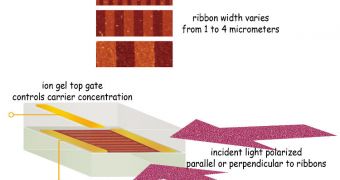A group of investigators in the United States announces the development of a system that represents the first demonstration of light and plasmon coupling in the carbon compound called graphene. The work also sets the foundation for using graphene as a basis for new generations of metamaterials.
This investigation was conducted by experts at the US Department of Energy’s (DOE) Lawrence Berkeley National Laboratory (Berkeley Lab) and the University of California in Berkeley (UCB).
Together, the investigators used light at terahertz wavelengths to control a microscale device that had a graphene-based core. The new material responds especially well to these wavelengths, and the reason for that is mainly the 2D nature of the carbon compounds.
Graphene is a hexagonal, honeycomb-like material that is made up entirely of carbon atoms. It has only two dimensions, which means that (unlike 3D materials) it responds to light of short wavelengths in very special ways. This is precisely what the science team counted on.
Terahertz light is located at the far end of the infrared spectrum, featuring wavelengths of hundreds of micrometers (millionths of a meter). When this light hits graphene, it produces collective oscillations of electrons called plasmons.
Plasmons are produced differently in 2D and 3D materials, which is what makes the new microscale device so important. Given that terahertz radiation can be used to fine-tune the response the carbon compound produces in terms of plasmons, researchers hope to be able to create new materials soon.
“The heart of our device is an array made of graphene ribbons only millionths of a meter wide. By varying the width of the ribbons and the concentration of charge carriers in them, we can control the collective oscillations of electrons in the microribbons,” expert Feng Wang explains.
The researcher holds joint appointments, as a researcher at the Berkeley Lab Materials Sciences Division, and as an assistant professor of physics at UCB. He was also the leader of the research team.
“Plasmons in high-frequency visible light happen in three-dimensional metal nanostructures. But graphene is only one atom thick, and its electrons move in only two dimensions. In 2D systems, plasmons occur at much lower frequencies,” Wang explains.
He adds that metamaterials are a special class of materials that affect light in a very peculiar manner. They are entirely man-made, and have structures that are smaller than the wavelength of light researchers shine on them. Some metamaterials are used to research invisibility cloak technology.
“We have not only made the first studies of light and plasmon coupling in graphene, we’ve also created a prototype for future graphene-based metamaterials in the terahertz range,” Wang adds.
Details of the new research appear in the latest, advanced online issue of the top scientific journal Nature Nanotechnology, in a paper called “Graphene plasmonics for tunable terahertz metamaterials.”

 14 DAY TRIAL //
14 DAY TRIAL //